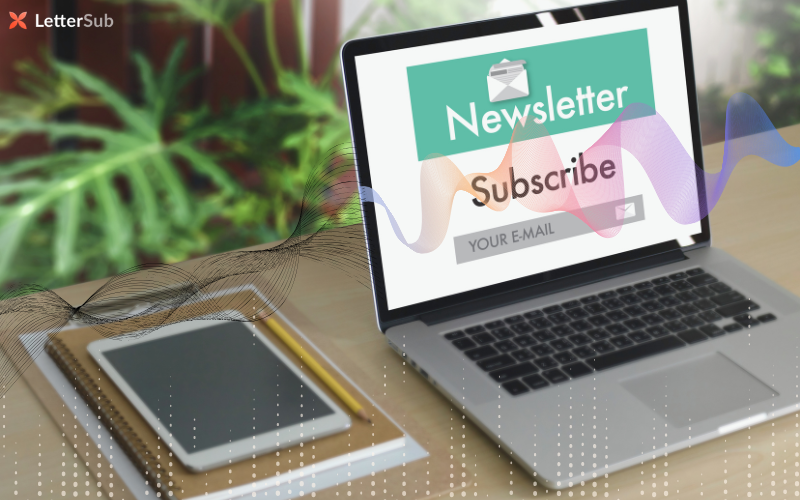Newsletter Frequency that Works: The Ultimate Guide to Boosting Open Rates and Retention

When it comes to newsletters, one question always comes up: How often should I send them? Too frequent, and you might annoy your readers. Not enough, and they might forget about you altogether. This blog dives into the factors that determine the perfect frequency for sending newsletters to keep your audience engaged while avoiding the pitfalls of overcommunication.
Whether you’re a business owner promoting a product, a blogger sharing stories, a content creator, or a coach offering expertise, this guide will help you create a newsletter strategy that engages readers, fosters loyalty, and drives results. Once you have your perfect newsletter frequency, you can use LetterSub to widen your audience. By fine-tuning your approach, you'll be able to grow your subscriber base, keep them hooked, and drive results. Let's explore how often you should be hitting that "Send" button.
What’s the “Best” Newsletter Frequency? Spoiler: There’s No One-Size-Fits-All

The truth is, there isn’t a magic number that works for everyone. It depends on your audience, industry, and content type. Some businesses thrive by sending newsletters daily, while others succeed with a monthly cadence.
Imagine this: You’re subscribed to a newsletter that sends emails every single day. At first, you might be excited. But soon enough, those daily emails clog up your inbox, and you stop opening them—or worse, you unsubscribe. On the flip side, think about a brand that sends you a newsletter once every six months. By the time their next email arrives, you’ve probably forgotten about them.
Newsletter frequency isn’t just about sending emails—it’s about maintaining a relationship. Get it right, and your subscribers will stay engaged. Get it wrong, and you risk losing their interest altogether.
Why does this matter?
Consistency is the backbone of newsletter success. If you send too many emails, your audience might unsubscribe. If you send too few, they might forget who you are. According to Campaign Monitor, businesses that send weekly newsletters often experience higher engagement rates than those that send sporadically.
For instance, an eCommerce brand with daily deals might benefit from sending emails every day, but a consultant offering educational content may perform better with a bi-weekly or monthly schedule.
Start with Your Audience: What Do They Want?

Imagine being in your reader’s shoes. How often would you want to hear from a brand like yours? If you’re not sure how often to send newsletters, start by listening to your audience. What do they want? How often do they want to hear from you? One of the easiest ways to find out is by asking directly through surveys or by adding a frequency preference option to your signup form.
Here’s why this works
Your audience’s preferences dictate their engagement levels. By listening to their needs, you’re not just guessing—you’re making data-driven decisions. Tools like Mailchimp and HubSpot allow you to segment audiences based on frequency preferences, ensuring you cater to everyone.
Your readers subscribed because they find value in your content. When you align your newsletter schedule with their preferences, they’re more likely to open and engage with your emails. Plus, gathering feedback shows your audience that you care about their experience.
Illustration
A lifestyle blog might send weekly newsletters to subscribers interested in recipes, while readers interested in home decor tips might prefer bi-weekly updates. Tailoring your frequency keeps both groups engaged without overwhelming them.
Analyze Your Content Strategy: What Do You Have to Offer?

The frequency of your newsletters should be directly tied to the content you’re producing. Consistency matters, but quality matters even more. If you don’t have enough valuable content to share, it’s better to send fewer emails than to overload your audience with irrelevant information.
This is important because overloading your audience with irrelevant information can lead to lower open rates and higher unsubscribe rates. Your readers subscribed because they find value in your content—don’t disappoint them.
Illustration
A travel blogger might send monthly newsletters featuring curated travel itineraries. This cadence works because it takes time to gather and create quality content. On the other hand, a fitness coach might send weekly tips, keeping subscribers motivated and engaged with fresh advice.
Test and Adjust: Let the Numbers Guide You

Finding the perfect frequency takes experimentation. Start with a baseline schedule—like sending newsletters weekly—and track your performance metrics, such as open rates, click-through rates, and unsubscribe rates. Adjust based on the results.
Testing works because your subscribers' behavior tells a story. Your audience’s behavior will tell you what works. If you notice a drop in engagement after increasing frequency, it’s a sign you might be sending too often. Similarly, if you see positive engagement spikes after trying a bi-weekly schedule, you’ve likely hit the sweet spot.
Illustration
An online bookstore began by sending newsletters bi-weekly. After testing, they discovered that a weekly schedule boosted sales without alienating subscribers. Testing allowed them to find a sweet spot.
Consider Industry Standards for Guidance

While personalization is key, it’s helpful to know what’s common in your industry. For example:
- eCommerce brands: 3-5 times per week
- Blogs and content creators: Weekly or bi-weekly
- B2B businesses: Monthly or bi-weekly
Why follow industry standards?
The industry standard will give you a starting point and prevent you from alienating subscribers. However, you will have to remember: to adjust based on your audience's response.
For instance, a SaaS company initially sent newsletters monthly. However, they found that their subscribers preferred weekly updates featuring tech tips and product insights. By following industry trends and adjusting to their audience, they boosted engagement rates.
Common Newsletter Schedules and Who They Work For

Now that you know the importance of frequency, let’s look at some common schedules and how they work:
1. Weekly Newsletters
A weekly schedule is one of the most common choices. It’s frequent enough to keep your audience engaged without overwhelming them.
Weekly newsletters are great for sharing updates, tips, or new content regularly. Subscribers know when to expect your email, which helps build consistency and trust.
For instance, A fitness coach might send a weekly newsletter with workout tips, recipes, and motivational content to keep subscribers coming back.
2. Bi-Weekly Newsletters
If you don’t have enough content for a weekly email, bi-weekly newsletters can be a good alternative. It’s a great balance for businesses that want to stay top-of-mind without overloading their subscribers.
For example, a small business owner might send bi-weekly newsletters featuring product updates, blog highlights, or upcoming sales.
3. Monthly Newsletters
Monthly emails are perfect for industries where content doesn’t change frequently, or for businesses that focus on in-depth updates. It works because your subscribers won’t feel bombarded, and you’ll have plenty of time to curate valuable content.
For instance, a nonprofit might send a monthly newsletter with success stories, donor highlights, and upcoming events.
How to Find the Perfect Frequency for Your Newsletter

If you’re just starting, finding the perfect frequency can feel like a guessing game. But here’s a simple plan to help:
- Start with a Monthly Schedule: If you’re unsure, start small. A monthly newsletter is easy to manage and won’t overwhelm your audience.
- Test and Adjust: Pay close attention to your open rates, click-through rates, and unsubscribe rates. If subscribers seem engaged, consider increasing your frequency. If they’re disengaged, pull back.
- Ask Your Subscribers: Sometimes, the simplest way to find out what your audience wants is to ask. Use a poll or survey to learn their preferences.
Mistakes to Avoid When Scheduling Newsletters
1. Sending Too Many Emails
Sending a lot of newsletters too much to your audience can lead to unsubscribes. You have to make sure that every newsletter/email that you send provides value for your target audience. If they are unsubscribing your email, it means there is something wrong with your email frequency or your email content.
2. Being Too Inconsistent
If you send emails not at the same time, your target audience might lose interest. However, if you send it consistently, they will wait and know that you are being organized with your email. Stick to a consistent schedule to make them know that you know what you are expert in.
3. Ignoring Subscriber Feedback
Getting feedback from your audience is important. It is important to ask for their feedback. Sometimes, they are too shy to give feedback. One thing you can do is give them a small reward for their feedback. Once you get their feedback, make sure you give them your thank you. You need to pay attention to their behavior and adjust your strategy accordingly.

Finding the perfect frequency for your newsletter is all about balance. You want to stay connected with your audience without overwhelming them. Start small, test different schedules, and focus on providing value with every email. Remember, quality always beats quantity.
At LetterSub, we’re here to help you amplify your newsletters and reach the right audience. Whether you’re just starting or looking to improve your open rates, our tools can help you create, manage, and promote your newsletters with ease.
